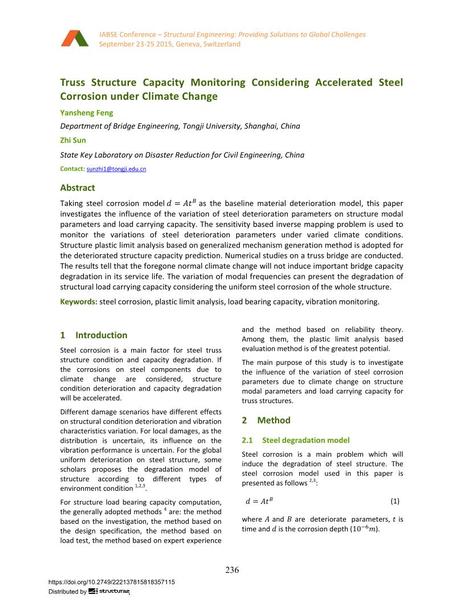Truss Structure Capacity Monitoring Considering Accelerated Steel Corrosion under Climate Change

|
|
|||||||||||
Détails bibliographiques
| Auteur(s): |
Yansheng Feng
(Department of Bridge Engineering, Tongji University, Shanghai, China)
Zhi Sun (State Key Laboratory on Disaster Reduction for Civil Engineering, China) |
||||
|---|---|---|---|---|---|
| Médium: | papier de conférence | ||||
| Langue(s): | anglais | ||||
| Conférence: | IABSE Conference: Structural Engineering: Providing Solutions to Global Challenges, Geneva, Switzerland, September 2015 | ||||
| Publié dans: | IABSE Conference Geneva 2015 | ||||
|
|||||
| Page(s): | 236-241 | ||||
| Nombre total de pages (du PDF): | 6 | ||||
| Année: | 2015 | ||||
| DOI: | 10.2749/222137815818357115 | ||||
| Abstrait: |
Taking steel corrosion model d = AtB as the baseline material deterioration model, this paper investigates the influence of the variation of steel deterioration parameters on structure modal parameters and load carrying capacity. The sensitivity based inverse mapping problem is used to monitor the variations of steel deterioration parameters under varied climate conditions. Structure plastic limit analysis based on generalized mechanism generation method is adopted for the deteriorated structure capacity prediction. Numerical studies on a truss bridge are conducted. The results tell that the foregone normal climate change will not induce important bridge capacity degradation in its service life. The variation of modal frequencies can present the degradation of structural load carrying capacity considering the uniform steel corrosion of the whole structure. |
||||
| Mots-clé: |
monitoring de vibrations
|
||||
